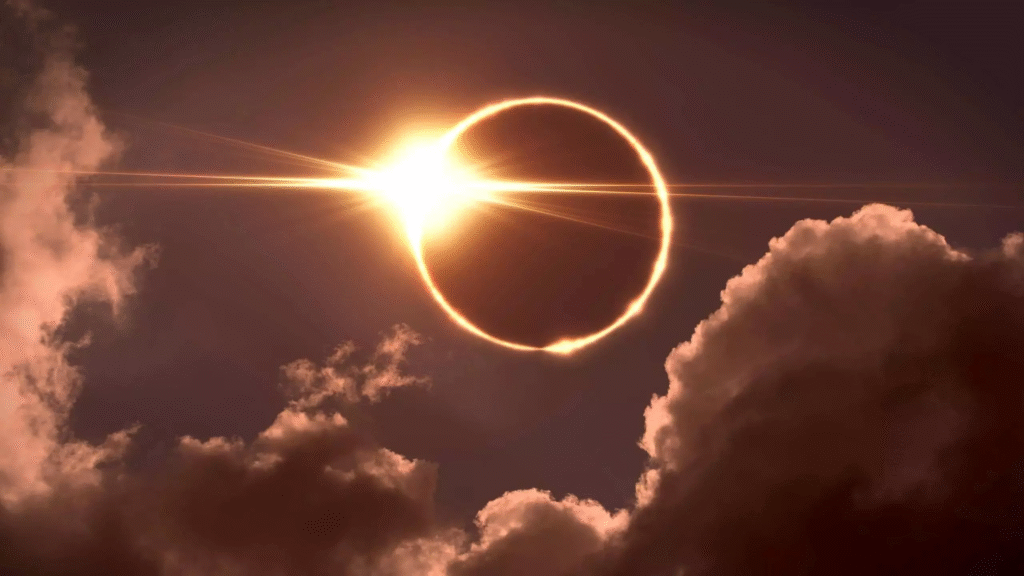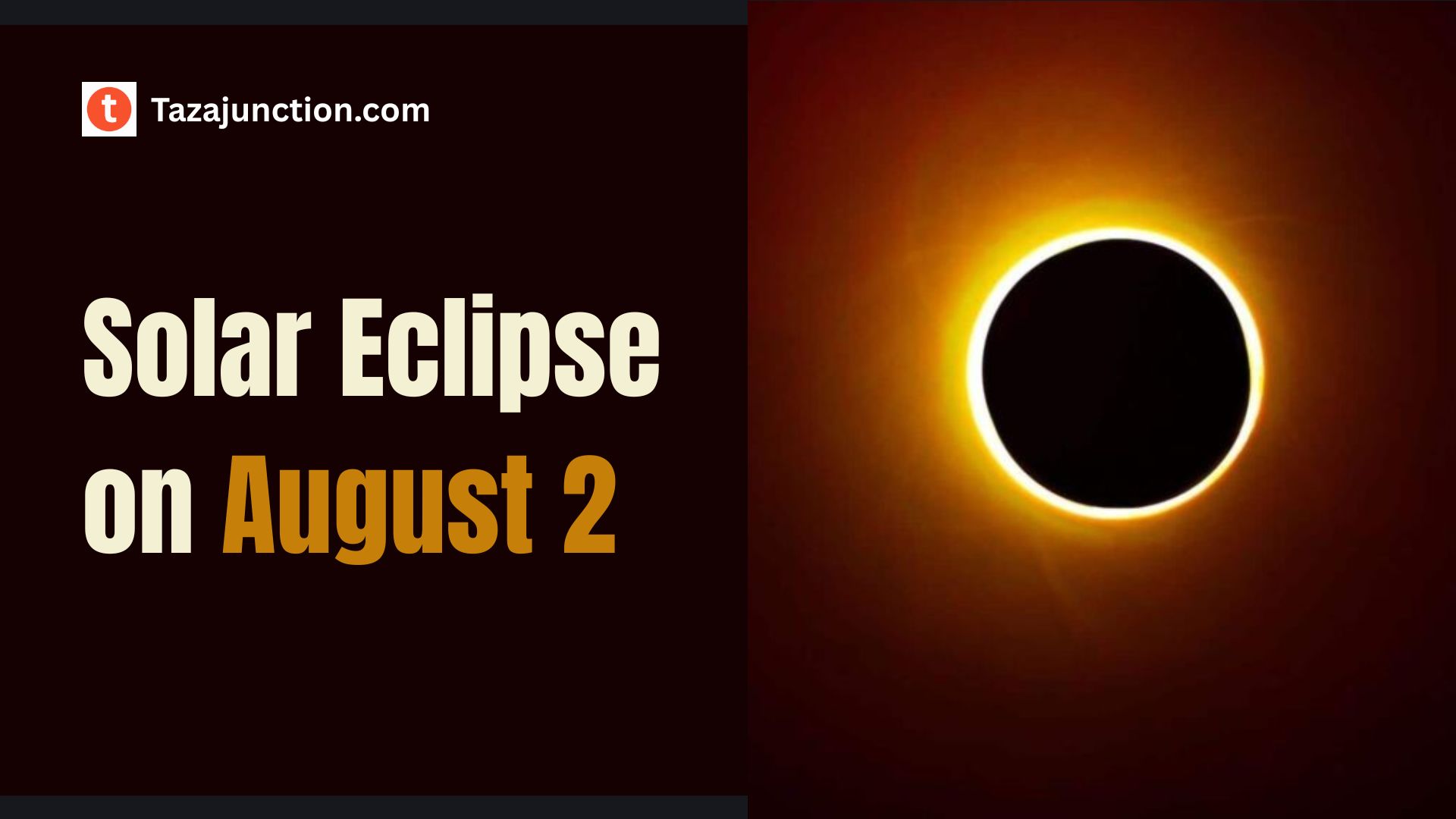Celestial events like solar eclipses have fascinated humanity for centuries. On August 2, 2027, skywatchers around the world will witness a total solar eclipse, one of the most dramatic astronomical phenomena.
While this eclipse will be widely visible in parts of Europe, North Africa, and the Middle East, the big question for many Indian observers is: Will it be visible in India?
Let’s explore everything you need to know about the August 2 solar eclipse — including its path, timings, scientific importance, and what to expect if you’re watching from India.
Table of Contents
🌑 What is a Solar Eclipse?
A solar eclipse happens when the Moon passes between the Earth and the Sun, partially or completely blocking the Sun’s light. There are three main types of solar eclipses:
- Partial Eclipse – The Moon covers only a portion of the Sun.
- Annular Eclipse – The Moon covers the center of the Sun, leaving a “ring of fire.”
- Total Eclipse – The Moon fully covers the Sun, creating moments of total darkness during the day.
The August 2, 2027 event is a total solar eclipse, meaning the Moon will entirely block the Sun for observers located along the path of totality.
📍 Path of the Eclipse: Where Will It Be Visible?
The path of totality — the narrow band where the Sun will be completely obscured — begins in the Atlantic Ocean, moves through southern Europe (especially Spain), crosses over North Africa (including Morocco, Algeria, and Egypt), and ends in Saudi Arabia, Yemen, and parts of East Africa.
Observers in these regions will experience daylight turning to darkness for up to 6 minutes and 23 seconds, making this one of the longest total eclipses of the 21st century.
Will the Solar Eclipse Be Visible in India?

While the full total eclipse will not be visible in India, a partial solar eclipse will be observable in many parts of the country, especially in western and northern regions.
Here’s a breakdown of what to expect:
- Total eclipse: Not visible in India
- Partial eclipse: Yes, especially in Rajasthan, Gujarat, Maharashtra, and parts of Delhi, Punjab, and Uttar Pradesh
- Eastern and southern states like West Bengal, Odisha, Tamil Nadu, and Kerala may see very limited or no visibility
The magnitude of the eclipse (how much of the Sun is obscured) in India will vary, ranging from 5% to 20%, depending on your location and weather conditions.
If you love to ride, then you can take your next ride with Yamaha Motor because India has officially launched the all-new 2025 Yamaha FZ X Hybrid model.
🕓 Timing of the Eclipse in India
The eclipse will occur during the afternoon hours, and it will be close to sunset in many places. Here’s a general idea of the timings:
- Start of Partial Eclipse: Around 3:00 PM to 4:00 PM IST
- Maximum Eclipse: Around 4:30 PM to 5:30 PM IST
- End of Eclipse: Close to 6:00 PM, or sunset, depending on location
Exact timings will differ from city to city. In Mumbai, for example, the partial eclipse may start around 4:15 PM and peak at 5:10 PM, whereas in Delhi, it may be slightly earlier.
🧠 Why Is This Eclipse So Special?
There are several reasons why astronomers and eclipse chasers are calling this one of the most remarkable eclipses in decades:
- Long Duration of Totality: Up to 6 minutes and 23 seconds of total eclipse in some locations — significantly longer than the average.
- Wide Path of Visibility: The eclipse will be seen across multiple continents including Europe, Africa, and Asia.
- Scientific Opportunity: Researchers will use this eclipse to study solar flares, coronal mass ejections, and the Sun’s magnetic field.
- Cultural Significance: In many cultures, eclipses are seen as powerful omens or natural marvels.
🔭 How to Safely Observe the Eclipse?
Whether you’re in the path of totality or observing a partial eclipse in India, safety is paramount. Never look at the Sun directly without proper protection, even if it’s partially obscured.
Here’s how to view the eclipse safely:
- Use ISO-certified eclipse glasses
- Avoid sunglasses or homemade filters
- Use solar filters on telescopes or binoculars
- Try pinhole projection techniques to safely project the Sun’s image onto a surface
- Watch live streams of the eclipse from regions experiencing totality
For children and schools, this is an excellent educational opportunity — but only under guided supervision and with proper safety gear.
🔬 The Science Behind the Spectacle
Solar eclipses aren’t just beautiful — they are scientifically valuable. During a total eclipse, the Sun’s outer atmosphere (corona) becomes visible, allowing researchers to study solar winds and plasma behavior.
Astronomers also use eclipses to:
- Monitor temperature changes on Earth
- Study wildlife and animal behavior
- Capture rare astronomical images of the Moon’s silhouette and Sun’s corona
- Calibrate satellite instruments by observing how solar radiation dips during the eclipse
🌐 Eclipse Around the World
Outside India, many nations will experience complete totality. Cities like Seville and Granada in Spain, Tunis in Tunisia, and Luxor in Egypt are expected to witness several minutes of total darkness. Tourism activity is expected to spike in these areas, with many planning to travel along the path of totality to experience the event firsthand.
For those unable to travel, many global observatories and space agencies will provide real-time online broadcasts of the eclipse from multiple viewing locations.
📷 Capturing the Eclipse: Tips for Photography
If you plan to photograph the eclipse in India, keep these tips in mind:
- Use a solar filter for your camera lens
- Use a tripod for stability during long exposures
- Try capturing the phases of the eclipse, especially as the Moon starts and ends its path
- Never point your camera at the Sun without protective filters
- Practice before the event to get familiar with your equipment
Even a partial eclipse offers stunning opportunities for silhouette shots, especially during sunset when the Sun appears closer to the horizon.
🛐 Cultural Beliefs and Myths
In India and many other cultures, solar eclipses carry mythological and spiritual significance. Some traditional beliefs include:
- Avoiding eating or cooking during the eclipse
- Bathing after the eclipse to purify oneself
- Performing prayers or chanting mantras
- Pregnant women being advised to stay indoors
While these are not backed by science, they remain part of cultural observances for many families.
🗓️ When Will India See the Next Total Solar Eclipse?
Although India won’t witness totality this time, the country will experience a total solar eclipse in the near future. Here are some upcoming eclipses:
- August 2, 2027: Partial in India
- July 22, 2028: Partial in southern India
- March 20, 2034: Total eclipse visible in parts of western India (Rajasthan and Gujarat)
These future eclipses will give Indian skywatchers a chance to plan ahead and experience the full spectacle.
✅ Conclusion
The August 2, 2027 solar eclipse is set to be a spectacular celestial event, with millions across Europe, North Africa, and the Middle East set to witness totality.
While India will not see a total eclipse, large portions of the country will still be able to view a partial solar eclipse, especially in the western and northern regions.
If you’re in India, prepare with eclipse glasses, check your local timings, and take this as a chance to educate, observe, and enjoy the wonders of our solar system — safely and responsibly.
Whether you’re a seasoned astronomer or simply a skywatching enthusiast, August 2 will be a day to remember.

